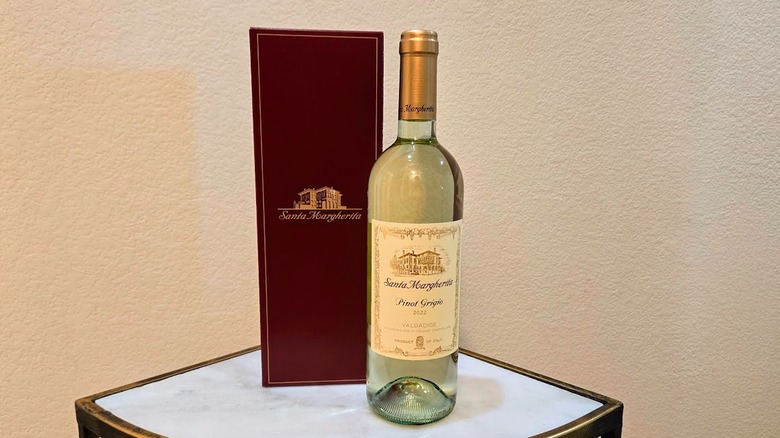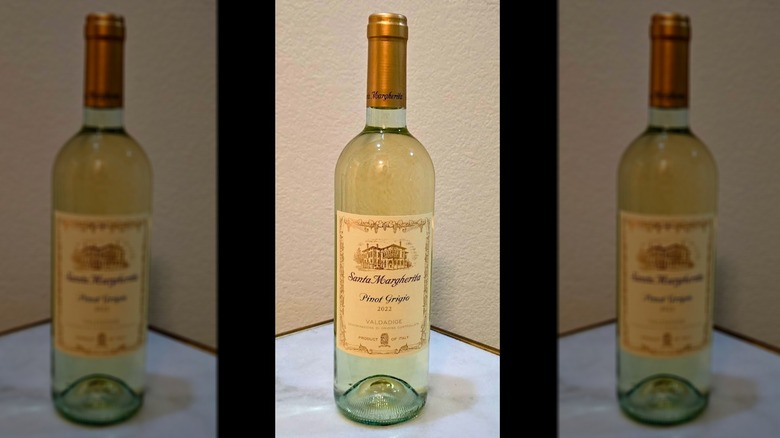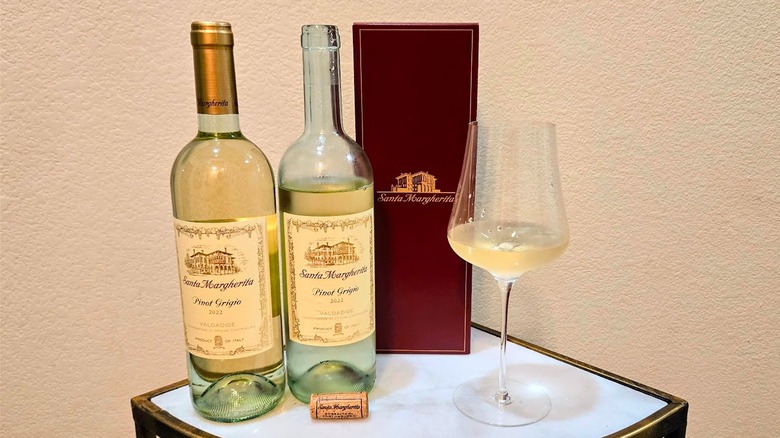Santa Margherita Pinot Grigio: The Ultimate Bottle Guide
Loved throughout the world for its light, refreshing character, pinot grigio is a fruit-forward wine that is bright, juicy, and thirst-quenching. While pinot grigio grapes are rendered into some of the most popular white wines in America, and the variety's roots are in France (where it is known as pinot gris), the Italians have made the wine their own — and the company widely recognized as helping put the modern-day style of pinot grigio on the map is Italy's Santa Margherita Winery.
Pinot grigio is similar to other light- to medium-bodied selections, like sauvignon blanc. However, these two varieties should not be confused, as pinot grigio and sauvignon blanc are more different than you'd think, namely in how the grapes display their terroir. Santa Margherita's goal with its pinot grigio is to produce a wine that intrinsically showcases its Italian terroir while focusing on sustainable winemaking, allowing regional characteristics to come through in the aromas and flavors of the wine. The crisp and clean result is a pinot grigio favored by celebrities, influencers, and everyday wine drinkers who enjoy balanced, easy-to-drink whites.
But what is it about Santa Margherita that has kept this almost 90-year-old winery and its signature white at the forefront for so many years? With curiosity, we obtained a sample of the product from the producer and began researching its history to provide this complete Santa Margherita Pinot Grigio bottle guide.
Recommendations are based on firsthand impressions of promotional materials and products provided by Santa Margherita.
History of Santa Margherita
Santa Margherita is synonymous with pinot grigio. The winery's story began in 1935, when Count Gaetano Marzotto purchased some 2,500 acres of land in Northeastern Italy's Veneto region to begin producing grains, dairy, meat, and wine. When deciding what to call this place, the count took inspiration from his wife Margherita, and named the winery after her.
Focusing on innovation and modern technologies, Count Marzotto first began making sparkling wine with the production of Santa Margherita Prosecco Superiore in the rolling hillsides of Italy's Conegliano-Valdobbiadene, transforming Glera grapes into a youthful, vibrant, and refreshing drink with zesty effervescence. Shortly after that, in the late 1950s, Marzotto's attention turned to creating a unique offering that would change consumers' perception of white wine, while showcasing the Italian terroir. With the help of his enologists and a forward-thinking approach, he set his sights on the production of pinot grigio. His thought was to reimagine what this wine variety could be, departing from its typical production style — which was richer, more textural, and tannic — into something youthful, vibrant, and entirely different.
Launching its pinot grigio wine in 1961, Santa Margherita became an ambassador for the dry, light, golden-hued style, helping the variety become Italy's most widely exported white wine. Pinot grigio would not only take Marzotto's home country by storm but change the way producers worldwide would make this variety in the future. Bottles of Santa Margherita Pinot Grigio have been savored in at least 90 countries.
The terroir is essential to Santa Margherita
The location of Santa Margherita's winery within the Valdadige Denominazione di Origine Controllata (DOC) of Northern Italy's more extensive Trentino-Alto Adige DOC is a crucial aspect of what makes the company's pinot grigio unique. Today, the area has a mix of Italian, German, and Austrian influences. Its history shows that this is an ideal place for agriculture, with evidence indicating that the first cultivation of grapes dates as far back as the seventh century B.C.
Valdadige takes its name from the Adige River running through much of the area's rocky, sloping hillsides near the foothills of the Dolomite Mountains. These hills are home to most of the region's vineyards, with the northern end being where Santa Margherita grows its pinot grigio fruit, where higher elevations bring mineral-rich character to the wines.
Hot summer days give way to cool evenings and mornings here, creating a long, steady, stable growing season with a temperate climate where grapes can ripen slowly, creating fruit-forward flavors while maintaining freshness. Alluvial vineyard soils are rich with glacial deposits and marine sediments that blend limestone, marl, and clay, contributing minerality to the wine. The diversity and uniqueness of the Valdadige DOC allow the wines to show a sense of place.
How is Santa Margherita Pinot Grigio made?
Before the launch of Santa Margherita Pinot Grigio, this grape variety was typically vinified in Italy with a production style known as ramato that creates full-bodied wine with texture, savoriness, and an orangish-copper hue. This was how Italian pinot grigio was traditionally produced prior to the 1960s.
The color of ramato-style pinot grigio comes from the grape's skin, which can range from bluish gray to pinkish copper. Allowing the grape juice to macerate with the skins will add color and tannin to the juice. Santa Margherita's innovative approach was to press the juice softly yet quickly to extract as little color as possible.
By hand harvesting most of its fruit, the producer ensures that its delicate grapes remain intact until they reach the winery for quick pressing. Grapes are also harvested early, capturing as much fresh acidity in the wine as possible, often before achieving full ripeness. Following this method, the finished wine has a hint of yellow-straw color, with a light body and refreshing acidity. After a 10-day to two-week cool fermentation, the 12.5% alcohol-by-volume wine is kept at approximately 60 degrees Fahrenheit until bottling, with minimal aging and zero use of oak to ensure only youthful, fresh, fruity flavors come through. This wine is also vegan-friendly, using only vegetable-based products for fermentation and filtration.
What does Santa Margherita Pinot Grigio taste like?
Santa Margherita engages your senses when sipping each glass. The light golden hue visually captures your attention, which leads to the enjoyment of delicate aromas of white flowers, apple blossom, ripe stone fruit, and citrus. A gentle swirl of the glass helps further release the floral and citrus notes, while the legs of the wine gently glide down the sides of the glass.
Upon tasting this pinot grigio, the palate is awash with green apple, ripe melon, red berries, and Rainier cherries. The mouthwatering finish is clean, and the palate is dry, with a hint of bitter almond. The style is finessed, with just the right amount of acidity to make the wine interesting but without overtaking its fruity character. Though Santa Margherita makes nearly 2 million bottles of pinot grigio every year, the wine doesn't have a mass-produced taste. Instead, it delivers Italian authenticity with a sense of place. There is refinement from the front to back palate that is enjoyable.
How to drink Santa Margherita Pinot Grigio
Santa Margherita's light, approachable flavor profile is a lovely option when enjoyed with or without food. The wine's fruit-forward character and racy acidity create youthful vibrancy that is best within the first few years of its production, when the flavors are at their optimal freshness. We suggest chilling the bottle to highlight the wine's thirst-quenching palate, with the proper serving temperature of this wine being around 50 degrees Fahrenheit. As this selection is not characterized by tannin, the cold temperature will not cause it to fall out of balance, though serving it too cold will hide its delicate aromas. Serving this in a tulip-shaped wine glass with a large bowl that narrows towards the top will best accentuate these aromas.
When serving this pinot grigio with food, consider options with a light flavor profile. A vegetable stir-fry would complement this wine well, as would grilled swordfish or branzino. A pasta dish like sweet pea ravioli with lobster would make an especially delicious pairing — the wine's natural acidity will cut through the richness of the shellfish, while the floral, herbal notes will enhance the earthy peas, as pinot grigio's fruitiness brings out the vegetable's sweetness. And, if you enjoy incorporating wine into your meal, Santa Margherita is one of the best white wines for cooking, as you should always cook with a wine you also want to drink.
Is Santa Margherita expensive?
When importer Anthony Terlato brought Santa Margherita Pinot Grigio to the American market in 1979, he positioned the wine as a super-premium product, a rarity for Italian white wines of the time. He sensed consumers were ready for a high-quality white wine with a clean, refreshing style, and believed they would be willing to pay a high price, initially over $10 a bottle. The price is now typically around $25, and it is now one of the best-selling white wines in that price category.
While scores of pinot grigio brands are on the market priced for much less, not all have the quality and style of Santa Margherita. Still, while the winery's focus on sustainability and environmental initiatives has increased over the years, the wine inside the bottle hasn't changed significantly since it held a $10 price tag instead of $25.
When comparing Santa Margherita Pinot Grigio to comparable wine categories, the product fares far better, as Italian pinot grigio as a whole costs much less than other luxury wines, like a French pinot gris. While Santa Margherita is less expensive than other white wine options, we recommend skipping this selection while dining in a restaurant. As it remains one of the most popular wines in America with wide recognition, restaurateurs often offer this wine by the glass at their establishments and drive up profits by sometimes selling a single serving for more than it costs for an entire bottle.
How does Santa Margherita compare to other pinot grigio wines?
Tasting Santa Margherita side-by-side with other options from fruit grown within Trentino-Alto Adige, and specifically within Valdadige, shows many similarities and a few differences. Overall, each selection — including fantastic offerings from Abbazia di Novacella and Colterenzio, both from Alto Adige — shows complementary juicy orchard fruit and stone fruit flavors with zesty citrus, white flowers, and crushed stone minerality. These two selections each cost less than Santa Margherita but are still relatively comparable while delivering a similar overall style. The availability of these wines, as well as some other options from Alto Adige, can be somewhat limited in the United States, but the production and availability of pinot grigio is growing.
Upon trying Cavit Pinot Grigio from Valdadige and comparing it with Santa Margherita, we were immediately taken by the bold, fruit-forward aromas of Cavit, especially compared to the more delicate notes from Santa Margherita. Aromas of green apple, golden citrus, and bitter almonds lift from the glass, drawing you in. The palate is more rustic than Santa Margherita, without quite as much finesse. It is a wine most enjoyable with food, whereas Santa Margherita is easy to sip on its own, thanks to its light style. However, the Cavit wine is certainly enjoyable, especially when considering the price, which can be half the cost of Santa Margherita.
Santa Margherita changed the way people drank pinot grigio
American wine consumers can thank Santa Margherita for creating the style of pinot grigio we enjoy today. Count Marzotto's approach of quickly pressing the grape's must apart from the skins, extracting as little color as possible, quickly caught on in other parts of Italy, and eventually the globe. Wineries worldwide now showcase this light, fresh, fruity white wine with a subtle hay-colored hue, a dry palate, and zesty acidity. The company estimates that some 150,000 glasses of this pinot grigio style are enjoyed internationally every day.
In America, Santa Margherita's management hopes that the glassfuls consumed here are from their winery, as the company has spent decades building brand loyalty within the country. It started in 1979 when importer Anthony Terlato first tasted this now-iconic white wine. While Marzotto changed the overall production of pinot grigio with his innovative, forward-thinking approach, his company's partnership with Terlato brought the wine to America, introducing the new style of this varietal. Soon after, other Italian winemakers — and eventually international producers — followed suit, producing the lighter style of pinot grigio.
By 2016, it was reported that Terlato was selling over 600,000 cases of Santa Margherita in the U.S. annually. Santa Margherita continues to grow its presence here, ensuring widespread distribution throughout the country.
Sustainability is a focus for the winery
Santa Margherita's commitment to sustainability is a fundamental practice for the winery, and a philosophy in place since the company's founding. There is a belief throughout the enterprise that by employing sustainable practices, you create a socially responsible workplace that is better for the environment as a whole, as well as the people who work and live amid it.
By embracing its Italian heritage while working with modernity and innovation, the winery creates a better livelihood for its people. Utilizing sustainable farming practices with natural materials like copper and sulfur, the fruit is kept healthy and clean. The winery's hands-off approach creates selections with geographical authenticity that showcase the terroir.
Santa Margherita's winery and headquarters are run with renewable energy, like solar power. The company's glass-manufacturing plant was strategically sited next to the fermentation facility to share this clean energy. By producing the majority of its wine bottles next to the winery — many of which are made with recycled materials — Santa Margherita cuts carbon emissions from bottle transportation. To further its dedication to sustainability, the winery earned a carbon neutrality certification for all pinot grigio wines produced for the Canadian market. While such practices help boost the company's environmental stewardship, they are also good for the wine and the people who make it.
Celebrities, influencers, and musicians love Santa Margherita
Celebrities associating themselves with popular brands is nothing new; stars ranging from Elizabeth Taylor to Taylor Swift have endorsed products like perfume, makeup, clothing lines, and alcohol brands. However, the affinity for Santa Margherita Pinot Grigio has an almost organic effect, as the popularity of this premium product has penetrated society. Canadian rapper Drake enjoys Santa Margherita by the liter, as he notes in his song "Motto."
Kylie Jenner, Katy Perry, Rhianna, and Eileen Davidson have all been noted as enjoying it in the past, and it's a common Instagram theme among many wine lovers, as Santa Margherita is an affordable luxury. While the price is higher than that of comparable offerings, its positioning as a premium brand elevates its perception, making this an attainable indulgence. Millennials and members of Gen Z have shown a willingness to pay more for a premium tipple in recent years, especially one that focuses on sustainable production, and so Santa Margherita Pinot Grigio remains ahead of its time.










